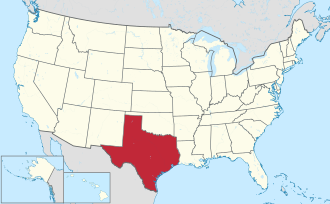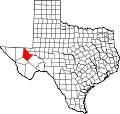History
Native Americans
Prehistoric Clovis culture peoples [5] in Reeves County lived in the rock shelters and caves nestled near water supplies. These people left behind artifacts and pictographs as evidence of their presence. [6] Jumano Indians led the Antonio de Espejo [7] 1582–1583 expedition near Toyah Lake on a better route to the farming and trade area of La Junta de los Ríos. Espejo's diary places the Jumano along the Pecos River and its tributaries. [8] The Mescalero Apache [9] [10] frequented San Solomon Springs to irrigate their crops. In 1849, John Salmon "RIP" Ford [11] explored the area between San Antonio and El Paso, noting in his mapped report the productive land upon which the Mescalero Indians farmed.
County established and growth
The state legislature formed Reeves from Pecos County on April 14, 1883, and named it after Texas legislator and soldier George Robertson Reeves. [12] [13] The county was organized on November 4, 1884. The town of Pecos [14] was named as county seat.
Toyah Valley farmers George B. and Robert E. Lyle were the first Anglo settlers 1871. White settlers started arriving in the area four years later, lured by open-range ranching. [15] For the remainder of the century, the county economy was dependent upon farming and ranching as it moved into the manufacturing and oil industries of the 20th century.
The Texas and Pacific Railway built through Reeves County in 1881, with stations at Pecos [16] and Toyah. [17] By 1890, the Pecos River Railway [18] had built from Pecos to New Mexico. Toyahvale, [19] which means "flowing water", became the western terminus of the railroad.
Balmorhea State Park was built at Toyahvale by the Civilian Conservation Corps. [20] The park was deeded to the State of Texas in 1934 and opened to the public in 1968.
Pecos Army Air Field was one of the 120 airbases that trained the pioneer Women Airforce Service Pilots [21] to fly military aircraft. At the Pecos installation, WASP flew AT-6, UC-78, and AT-17 aircraft in engineering tests, administrative duties, and transporting freight. The base was activated in 1942 as a World War II pilot school. [22] The base was deactivated in 1945. At its peak, the base population of 4,034 rivaled the town of Pecos in size. Portions of the base were sold off over the years, with Pecos Municipal Airport retaining the remainder.
Pecos is the site of the largest private prison in the world, the Reeves County Detention Complex, operated by the GEO Group. [23]
Demographics
Historical population| Census | Pop. | Note | %± |
|---|
| 1890 | 1,247 | | — |
|---|
| 1900 | 1,847 | | 48.1% |
|---|
| 1910 | 4,392 | | 137.8% |
|---|
| 1920 | 4,457 | | 1.5% |
|---|
| 1930 | 6,407 | | 43.8% |
|---|
| 1940 | 8,006 | | 25.0% |
|---|
| 1950 | 11,745 | | 46.7% |
|---|
| 1960 | 17,644 | | 50.2% |
|---|
| 1970 | 16,526 | | −6.3% |
|---|
| 1980 | 15,801 | | −4.4% |
|---|
| 1990 | 15,852 | | 0.3% |
|---|
| 2000 | 13,137 | | −17.1% |
|---|
| 2010 | 13,783 | | 4.9% |
|---|
| 2020 | 14,748 | | 7.0% |
|---|
| 2024 (est.) | 11,956 | [25] | −18.9% |
|---|
|
As of the third quarter of 2024, the median home value in Reeves County was $117,940. [30]
As of the 2023 American Community Survey, there are 4,145 estimated households in Reeves County with an average of 2.94 persons per household. The county has a median household income of $56,056. Approximately 17.6% of the county's population lives at or below the poverty line. Reeves County has an estimated 58.1% employment rate, with 6.9% of the population holding a bachelor's degree or higher and 71.3% holding a high school diploma. [2]
The top five reported ancestries (people were allowed to report up to two ancestries, thus the figures will generally add to more than 100%) were English (38.5%), Spanish (61.3%), Indo-European (0.0%), Asian and Pacific Islander (0.2%), and Other (0.0%).
The median age in the county was 34.4 years.
Reeves County, Texas – racial and ethnic composition
Note: the US Census treats Hispanic/Latino as an ethnic category. This table excludes Latinos from the racial categories and assigns them to a separate category. Hispanics/Latinos may be of any race.
| Race / ethnicity (NH = non-Hispanic) | Pop. 1980 [31] | Pop. 1990 [31] | Pop. 2000 [32] | Pop. 2010 [33] | Pop. 2020 [34] |
|---|
| White alone (NH) | 5,561
(35.19%) | 3,909
(24.66%) | 3,131
(23.83%) | 2,690
(19.52%) | 1,697
(11.51%) |
| Black or African American alone (NH) | 358
(2.27%) | 340
(2.14%) | 238
(1.81%) | 672
(4.88%) | 224
(1.52%) |
| Native American or Alaska Native alone (NH) | 23
(0.15%) | 26
(0.16%) | 34
(0.26%) | 21
(0.15%) | 27
(0.18%) |
| Asian alone (NH) | 33
(0.21%) | 31
(0.20%) | 46
(0.35%) | 118
(0.86%) | 165
(1.12%) |
| Pacific Islander alone (NH) | — | — | 0
(0.00%) | 2
(0.01%) | 3
(0.02%) |
| Other race alone (NH) | 36
(0.23%) | 1
(0.01%) | 3
(0.02%) | 20
(0.15%) | 39
(0.26%) |
| Mixed race or multiracial (NH) | — | — | 45
(0.34%) | 27
(0.20%) | 83
(0.56%) |
| Hispanic or Latino (any race) | 9,790
(61.96%) | 11,545
(72.83%) | 9,640
(73.38%) | 10,233
(74.24%) | 12,510
(84.83%) |
| Total | 15,801
(100.00%) | 15,852
(100.00%) | 13,137
(100.00%) | 13,783
(100.00%) | 14,748
(100.00%) |
2020 census
As of the 2020 census, there were 14,748 people, 4,178 households, and 2,895 families residing in the county. [35] The population density was 5.6 inhabitants per square mile (2.2/km2). There were 5,068 housing units at an average density of 1.92 per square mile (0.7/km2). The racial makeup of the county was 54.74% White, 1.97% African American, 0.68% Native American, 1.15% Asian, 0.02% Pacific Islander, 16.48% from some other races and 24.96% from two or more races. Hispanic or Latino people of any race were 84.83% of the population. [36]
2010 census
As of the 2010 census, there were 13,783 people, 3,839 households, and _ families residing in the county. The population density was 5.2 inhabitants per square mile (2.0/km2). There were 4,640 housing units at an average density of 1.76 per square mile (0.7/km2). The racial makeup of the county was 77.23% White, 5.01% African American, 0.46% Native American, 0.86% Asian, 0.04% Pacific Islander, 14.85% from some other races and 1.54% from two or more races. Hispanic or Latino people of any race were 74.24% of the population.
This page is based on this
Wikipedia article Text is available under the
CC BY-SA 4.0 license; additional terms may apply.
Images, videos and audio are available under their respective licenses.



